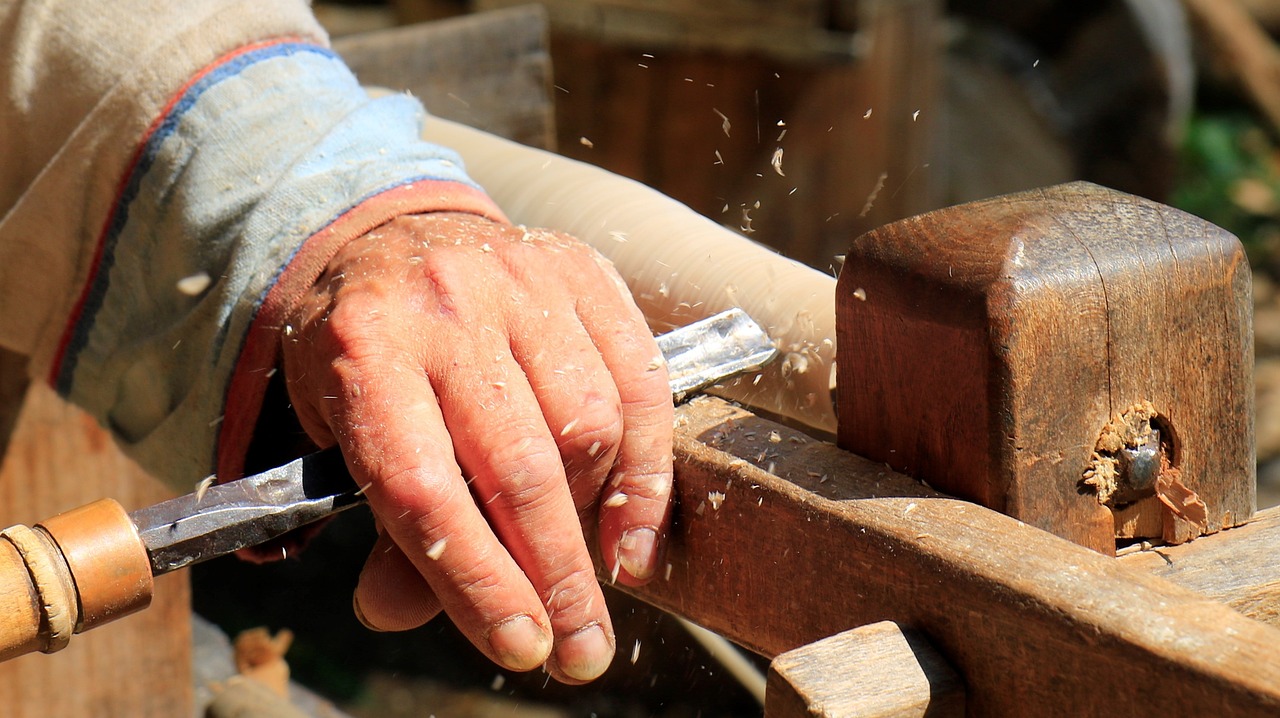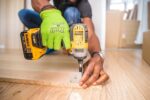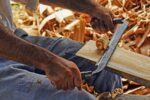Beginner Stage First
Becoming a woodworking expert requires going through the beginner stage first. Engaging in deliberate practice is what enables you to excel in woodworking.
To achieve the desired outcome in woodworking, we utilize both hand tools and power tools.
When you’re a beginner, it’s better to practice with hand tools to gain a valuable experience, despite the fact that power tools are more efficient and easier to use.
When starting out, it is crucial for beginners to focus on learning woodworking tips, techniques, and all other basic aspects of woodworking through the use of hand tools, rather than relying on power tools.
In this article, we will examine beginner woodworking hand tools individually and explore their functionality and the significance they hold in woodworking. This will allow us to gain insight into woodworking skills and techniques.
-
Ripping Handsaws
Handsaws are thought to be the fundamental tool that every woodworker possesses in woodworking.
The ripping handsaw is the type of handsaw that woodworkers primarily utilize among various types of handsaws.
The length of it is nearly 26 inches and it has 5 teeth-shaped blades for every inch.
A tooth saw, also called a ripping handsaw, is composed of blades with teeth-shaped patterns that alternate between left and right bending sides.
The wood can be cut along the direction of its grain.
When precision cuts are needed, using a handsaw for ripping is a straightforward and effortless process. They are affordable and deliver exceptional outcomes.
For beginners, handsaws that rip are highly versatile and can provide assistance in learning how to make precise cuts and achieve desired shapes in wooden materials.
The blades of the handsaw are evenly positioned.
To prevent wood movements during cutting, it is important to securely hold the wood when using a ripping handsaw.
Here are several beneficial features of a ripping handsaw:
- Able to cut preciously with the wood grain.
- Can make clean cuts with push strokes along the wood grain.
-
Crosscut Handsaws
Crosscut handsaws, also referred to as rip-cut handsaws, are significant for cutting across the grain of wood.
The teeth-shaped blades of the tool are situated in a reversed manner with bevel edges.
To achieve a clean and accurate cut, both push and pull strokes are employed while cutting.
If you want to cut a wood log perpendicular to its wood grain, a crosscut handsaw is the best tool you should go with.
The blades of the crosscut handsaw are arranged in a staggered manner.
In the realm of woodworking, beginners often encounter situations where they must cut along the wood grain or cut across it.
In order to cut along the natural direction of wood fibers, it is necessary to possess a handsaw specifically designed for ripping, while for cutting across the wood grain, a handsaw made for crosscutting is required.
It is evident that distinct woodcutting techniques require varying equipment.
Below are several practical functions of a crosscut handsaw:
- Able to make a clean and accurate cut across the wood grain.
- Can make cuts with both push and pull strokes.
The performance of crosscut handsaws is enhanced by the ease of sharpening and the improvement of its performance through breasted blade edges and taper ground.
-
Combination Handsaws
The combination handsaw is capable of performing both crosscuts and rips, making it a multifunctional tool. This means that by using a combination handsaw, you can accomplish the tasks traditionally done by both a ripping handsaw and a crosscut handsaw.
The combination handsaw is designed to handle well, thanks to its flexible, thin blade and rigid back.
The combination handsaw’s blades have both evenly spaced and staggered layouts.
If you’re new to woodworking and have a limited budget, it is advisable to opt for a combination handsaw instead of purchasing separate ripping and crosscut handsaws.
By using a combination handsaw, you can achieve two goals simultaneously.
A combination handsaw has several handy functions:
- Able to make clean, precious, and accurate cuts both across the wood grain and along the wood grain.
- Can make cuts with both push and pull strokes.
As a woodworker, it is important for you to have knowledge about the Points Per Inch (PPI) value of the handsaw on its blade:
- If the PPI value is high that means a higher number of teeth which are helpful to give clean, slow, and fine cuts.
- If the PPI value is less that means a lower number of teeth which are helpful to give aggressive, less fined, and faster cuts.
-
Back Saws
Back saws are equipped with thin metal blades that have fine teeth located on the top of the saw blade. These teeth are advantageous for creating precise, slow, and delicate cuts.
Back saws play a crucial role in creating wooden joints due to their precise and finely tuned capabilities.
The job of the saw can be altered by changing the tooth configuration of the backsaws. The backsaws have rectangular-shaped blades with braced backs which are suitable for milter cuts.
Here are a few practical functions of a combination handsaw:
- Able to make a clean, precious, and accurate cut due to fine teeth.
- Useful when making wooden joints.
-
Carcass Handsaws
The main purpose of a carcass handsaw is to create furniture carcasses. Additionally, carcass handsaws are a type of backsaw that is bigger and more durable than typical backsaws.
If you are a beginner, a carcass handsaw will be the most suitable choice for you.
The length of the carcass saw ranges from 11 to 14 inches and its PPI value falls within the range of 14 to 16.
The carcass handsaw has a considerable depth and length, making it suitable for cutting tenons, dovetails, and everything in between.
A carcass saw with a 250 hang angle can be used to cut both hardwoods and softwoods.
Here are a few practical functions of a combination handsaw:
- Useful for cutting small boards, miters, and anything in between.
- Useful when making wooden joints.
- All other general uses of the workbench.
The carcass handsaw is not suitable for making precise cuts, but it is most effective for creating deeper cuts.
-
Coping Handsaws
One of the most affordable handsaws, particularly suitable for beginners, is a coping handsaw that costs less than $20.
It is utilized for the removal of waste from dovetail joints and carrying out rough cuts in the boards.
The handle of the tool provides comfort, allowing for precise cuts with its sharp blades.
However, due to its slow cutting speed, the handsaw is resistant to buckling when subjected to a significant amount of tension. As a result, there is no risk of the handsaw jumping off the kerf at the end and causing any damage to the pin or tail.
The coping saw is beneficial for cutting curves due to its tall frame and thin blade. Additionally, it includes a pack of replaceable blades that are both useful and cost-effective.
To eliminate the waste caused by the chisel, one can utilize a coping handsaw.
A combination handsaw possesses several helpful functions:
- Useful for curve cuttings in small boards.
- Useful for removing waste from dovetail joints.
- Able to make cuts with pull strokes.
-
Dovetail Handsaws
Dovetail handsaws are utilized for various woodworking tasks, including creating hand-cut dovetails and making adjustments to drawers or shelves to fit into a dado on a case side.
If you have limited funds, using a dovetail handsaw is sufficient for a temporary period.
By using a dovetail handsaw, you will have the ability to accurately cut joinery in line with the wood grain. This type of saw is equipped with finely toothed edges specifically designed for manual dovetail cutting.
The dovetail saw has a PPI value of 15 and is furnished with a steel blade of the highest quality as well as a solid brass back.
To begin with, it is important to learn how to properly use the dovetail saw.
The incorrect method involves wrapping all fingers around the handle, which many people do.
To ensure proper technique, wrap the middle, ring, and little fingers around the handle while also placing the forefinger alongside the brass back.
The dovetail saw can be handled comfortably and naturally using this method.
One wise idea before diving directly into a large project is to begin by practicing saw cutting on scrap wood.
Once you have acquired the correct sawing technique, you will find it easy to make smooth cuts.
Below are several practical functions of the dovetail handsaw:
- Able to make small precise cuts that are extremely neat.
- Use for joint-making.
- Have better control and handling than many other handsaws.
-
Keyhole Handsaws
A compass saw, also referred to as a keyhole handsaw, is beneficial for cutting holes in softwoods. It is equipped with a petite, pointed blade that can also be utilized for cutting holes in a wall in order to install a new switch.
The keyhole saw stands out for its ability to accommodate different blade sizes ranging from 5 to 15 inches.
The common models of keyhole handsaws typically have 8 to 10 points per inch (PPI), while there are variations available with about 5 to 20 points per inch.
To cut using a handsaw with a keyhole, slowly move the saw back and forth through the line.
To avoid difficulty in removing, do not apply excessive pressure as the blade might become jammed.
Keyhole handsaws are affordable, but the expense of sharpening them exceeds your initial expectations.
Below are several practical uses for the dovetail handsaw:
- Use to make internal cuts.
- Use to cut small shapes, as piercing material.
- Use to make holes in drywall, boxes, pipes.
- Able to make small openings.
-
Marking Gauge
Creating a gauge is a fundamental woodworking manual instrument that is found in every woodworker’s collection of tools.
Various marking gauges are available in the market, each serving a different purpose.
- Traditional marking gauge
The traditional marking gauge, which is both inexpensive and highly useful for joinery tasks, operates on the surface using a pin.
- Cutting gauge
The cutting gauge is used to work on the surface by employing a knife. Its purpose is to achieve clean cuts without causing any damage to the surface.
The cost of the product is slightly higher compared to the traditional marking gauge.
It is worth maintaining the wood steady until the job is complete with every type of marking gauge.
Well-sharpened gouges are practical for creating parallel lines that indicate precisely where the flat wood should be cut.
Below are several typical functions of marking gauges:
- Able to make precise lines.
- Make the woodworking cuttings much easier.
- Useful for both experienced and beginner woodworkers.
-
Clamps
The use of clamps is beneficial for securing recently glued joints. Clamps measuring 10 to 12 inches are ideal for securing the majority of joints.
Clamps are beneficial until you acquire the skill to refrain from using them.
As you gain experience, you will acquire the ability to perform tasks without relying on clamps. However, until that point, it is beneficial to have G-clamps and F-clamps in order to learn various woodworking techniques.
When undertaking large projects, it is advisable to use a set of four high-quality clamps measuring ¾ inch in size. These clamp sets are generally affordable and serve as an extra hand for securing boards during activities such as drilling or screwing.
Here are some frequently encountered purposes of clamps:
- Useful to hold glued joints.
- Useful when drilling and screwing.
- Essential woodworking hand tool for every beginner in woodworking.
-
Jack Planes
Planes are utilized for cutting purposes rather than sanding or abrasion. Various types of planes are accessible in the market.
Each plane is equipped with a fixed blade that is used to remove wood fibers in order to achieve a smoother surface.
Planes can be classified based on their purpose.
In order to properly complete woodworking projects, it is important for every beginner to understand the various applications of each type of plane.
Jack planes are equipped with both curved and straight edges, which serve the purpose of jointing or smoothing wooden surfaces. The size of the blade is a determining factor as it indicates the amount of material that can be removed simultaneously.
Jack planes serve the purpose of smoothing uneven wooden surfaces and molding them until they achieve their ultimate dimension.
The low-angle jack plane is both lighter and more user-friendly.
If you are new to woodworking, I suggest using a low-angle jack plane instead of a conventional bench plane due to its excellent handling.
The ease of adjusting the mouth opening on this type of plane is greater than other types.
Here are a few typical uses for jack planes:
- Jack of all trades useful when shaping and jointing.
- Provide maximum support for cutting-edge.
- Able to make deep cuts by removing the stock.
-
Block Planes
The purpose of the block plane is to create precise and tiny shavings for the purpose of joinery and woodturning.
Ideal for the edges of tabletops, chamfering, and refining wooden drawers.
Block planes have high mobility due to their ability to be easily carried around on a belt.
The block plane, which is stout and small, is incredibly useful for slicing with its 6-inch low-angle size.
Low-angle block planes are more versatile compared to other block planes due to their excellent performance in confined spaces.
Below are several typical uses for block planes:
- Useful for tight work.
- Able to make small clean cuts.
- Useful in woodturning and making smooth joints.
- Able to trim wooden surfaces.
-
Joining Planes
Joining planes function similarly to jack planes, serving both to achieve a smooth surface and to connect multiple pieces.
In addition to flattening the surfaces of big boards, joining planes are also utilized to straighten the edges of the board.
Planes that are joined together possess elongated structures, enabling them to navigate uneven surfaces by removing irregularities and making them smoother and more level.
Most joining planes have wooden bodies that are 20-24 inches long. Joining planes with metal bodies are more durable than those with wooden bodies.
Here are some typical functions of planes joining together:
- Able to make smooth cuts.
- Able to join wood pieces together.
- Flatten and smoothen the surface.
-
Rabbet Planes
Rabbit planes are specifically designed for making precise adjustments to rabbets, and they are beneficial for creating perpendicular cuts along the wood grain.
In the market, you can find two main types of rabbet planes, namely the skew rabbet plane and the adjustable rabbet plane.
Both the plane iron and the skew rabbet plane have comparable features, but the plane iron is positioned in a skew rabbet plane in order to decrease the cutting angle and facilitate clean and effortless slicing along the wood grain.
Both the skew rabbet plane and the adjustable rabbet plane offer the option of adjusting the mouth opening.
These are a few typical purposes of rabbet planes:
- Able to cut along the direction of wood grain.
- Useful to make fine-tune rabbets.
- Useful to clean grooves and dados.
- Comfortability and workability are so high which is important for beginners in woodworking.
-
Scraper Planes
Scraper planes are utilized for the purpose of providing the ultimate finish to wooden surfaces. By employing scraper planes, you can effectively rectify any imperfections caused by the usage of other plane types.
With its size being small, this item is extremely comfortable to use and does not cause any damage to the wood.
The scraper plane consists of cabinet scrapers, which are fine wood fibers.
By using scraper planes, you can achieve a highly smooth surface without the need for sandpaper.
The challenging aspect of scraper planes lies in the sharpening process. If the blade angle is too angular, it becomes easier to create a sharp hook or burr that can deform or burnish aggressively.
Typically, scraper planes are used once the surface has been prepared using a smoothing plane.
Using a scraper plane instead of sandpaper enables you to enhance the wood grain.
Below are some typical purposes of scraper planes:
- Able to super-smooth surfaces.
- Able to take thin curls.
- Can be used for final leveling and smoothing.
-
Circular Saw
The circular saw is a flexible tool that has the capability to cut straight through different materials such as wood, metal, and plastic. Its ability to adjust the depth and angle of the blade makes it ideal for cutting lumber and sheet goods to the desired size. When selecting a circular saw, make sure to choose one that is suitable for your specific requirements.
-
Power Drill
When considering a power drill, it is important to find one that is user-friendly and has adjustable speed settings for better maneuverability. A power drill is essential for individuals who enjoy do-it-yourself projects as it can be utilized for various purposes, such as drilling holes or fastening screws.
-
Jigsaw
A jigsaw is a tool that is held by hand and is excellent for cutting intricate shapes and curves. It is well-suited for making cuts in thin materials like plywood and paneling. It is advisable to select a jigsaw that has a variable speed control and a replaceable blade for convenience.
-
Table Saw
If you have intentions of engaging in extensive woodworking, a table saw is a necessary tool. It is ideal for creating straight cuts on thick boards and sheet goods. When searching for a table saw, prioritize those with a potent motor, a spacious work surface, and an adaptable fence to ensure precise cuts.
-
Random Orbital Sander
When looking for a power tool suitable for sanding wood and other materials, consider a random orbital sander. It is user-friendly and provides a uniform, polished outcome. Ensure the sander you choose has adjustable speed options and an effective dust collection mechanism to maintain a tidy workspace.
-
Chisels
Chisels, which are hand tools, are ideal for shaping wood and constructing mortises and tenons. It is important to select chisels that are suitable for your specific project, considering their various sizes and shapes available.
-
Handheld Planer
When looking for a handheld planer, ensure that it is easy to grip and has the ability to adjust the depth settings. This tool is ideal for smoothing and flattening wood, as well as eliminating imperfections and modifying the wood’s thickness.
FAQs
What is the reasoning behind suggesting beginners to begin their woodworking journey with hand tools?
By starting with hand tools, beginners can develop their skills in basic woodworking techniques, acquire knowledge about the properties of wood, and gain practical experience before progressing to power tools. Hand tools enable precise control and encourage a more profound engagement with the craft.
Why are different types of handsaws important?
Various types of handsaws, comprising ripping, crosscut, and combination saws, are created with specific cuts in mind. To illustrate, a ripping saw is employed when cutting parallel to the wood’s grain, while a crosscut saw is utilized for cutting perpendicular to the grain.
What is the significance of planes in woodworking?
Planes are necessary tools in shaping and smoothing wood, and they include jack, block, joining, rabbet, and scraper planes. Each type of plane has its own designated role in the woodworking process, offering both versatility and control.
What is the function of a spokeshave in woodworking?
The primary purpose of a spokeshave is to shape and smooth curved surfaces in wood. It is particularly valuable for precise and intricate tasks.
For beginners in woodworking, how important is it to have a chisel set?
For beginners, having a chisel set is essential because it enables them to perform various tasks such as chopping, paring, shaping, carving intricate details, and creating joints.
What function does a mallet serve in woodworking?
When working with wood, a mallet is employed alongside a chisel or another tool to exert controlled force. Mallets, unlike metal hammers, provide improved control and do not cause any harm to your tools.
What is the significance of having sharpening tools in a beginner’s toolkit?
By sharpening tools, you can ensure that your hand tools remain effective. This maintenance process guarantees that your tools are consistently in optimum condition, ultimately resulting in improved outcomes and safer usage.
What is the significance of squares and tape measures in woodworking?
In woodworking, squares and tape measures play a crucial role in ensuring accurate measurement and alignment. They are essential for achieving precision in cuts and joints, ultimately resulting in a polished and professional appearance.
What is the process for a beginner to figure out which woodworking hand tools to purchase initially?
In order to determine which tools to purchase initially, beginners should consider the nature of their project. By comprehending the objective and utility of each tool, beginners can make a well-informed choice.






